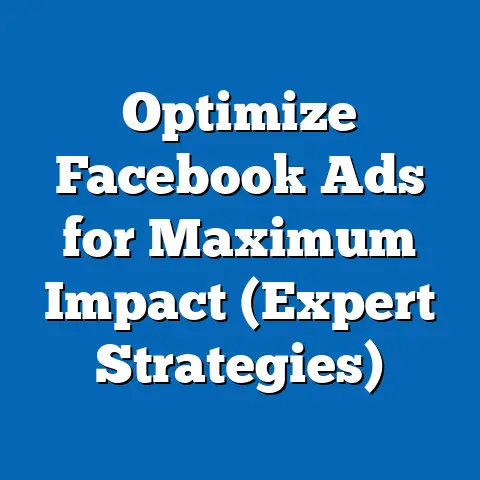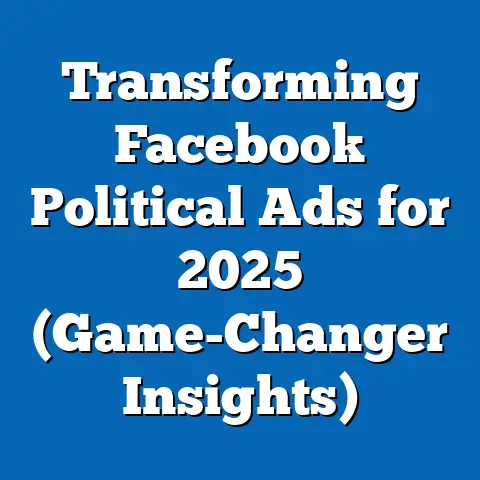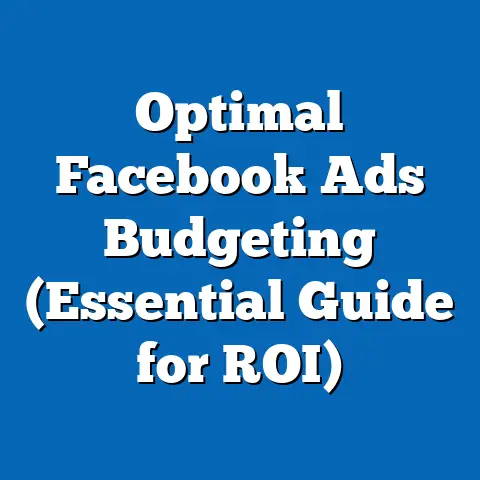Combat Fake News in Facebook Ads (Proven Strategies Revealed)
In an era defined by smart living—where technology permeates nearly every aspect of daily life—access to accurate information has become both a privilege and a challenge. Smart living, characterized by the integration of digital tools, artificial intelligence, and interconnected systems into personal and professional spheres, promises efficiency, connectivity, and informed decision-making. However, this digital revolution also brings with it the pervasive issue of misinformation, particularly through platforms like Facebook, where targeted advertisements often blur the line between fact and fiction.
The rise of smart living can be traced to the early 2000s, with the advent of smartphones, social media, and the internet of things (IoT). These innovations, while empowering individuals with unprecedented access to information, have also created fertile ground for the spread of fake news—false or misleading information presented as factual. This phenomenon has significant societal implications, from undermining trust in institutions to influencing elections and polarizing communities.
As we navigate this hyper-connected world, the proliferation of fake news in Facebook ads stands out as a critical challenge. With over 2.9 billion monthly active users as of 2023 (Statista, 2023), Facebook remains a dominant platform for information dissemination and advertising. This article explores the mechanisms behind fake news in Facebook ads, its societal impact, and proven strategies to combat it, tying these insights to the broader context of smart living and the need for digital literacy in the 21st century.
Defining Fake News in the Context of Facebook Ads
Fake news, often referred to as misinformation or disinformation, encompasses a range of content from fabricated stories to manipulated images and misleading headlines. On Facebook, fake news frequently appears in the form of advertisements, which are tailored to specific demographics through the platform’s sophisticated targeting algorithms. These ads can amplify false narratives by exploiting user data, emotional triggers, and confirmation biases.
Unlike organic posts, Facebook ads are paid content, often bypassing the scrutiny that user-generated content might receive through community reporting. According to a 2021 study by the University of Southern California, nearly 30% of political ads on Facebook contained verifiable falsehoods during the 2020 U.S. presidential election cycle (USC Annenberg, 2021). This highlights the scale of the problem and the urgent need for effective countermeasures.
The intersection of fake news and smart living lies in the reliance on digital platforms for information. As individuals increasingly turn to social media for news, the risk of encountering and sharing misinformation grows, undermining the potential of smart living to foster an informed society.
Historical Context: The Evolution of Misinformation in the Digital Era
The concept of misinformation is not new; propaganda and false narratives have existed for centuries, from wartime disinformation campaigns to political smear tactics. However, the digital age has exponentially amplified the speed and reach of fake news. The launch of Facebook in 2004 marked a turning point, as social media platforms became central to how people consume and share information.
The 2016 U.S. presidential election was a watershed moment for recognizing the impact of fake news on Facebook. Reports revealed that foreign actors, such as Russian operatives, used the platform to spread disinformation through ads and posts, influencing voter perceptions (Mueller Report, 2019). This event underscored the vulnerability of digital ecosystems to manipulation and prompted public and regulatory scrutiny of social media giants.
Since then, Facebook has faced criticism for its role in disseminating misinformation during major global events, including the Brexit referendum, the COVID-19 pandemic, and various national elections. These historical milestones illustrate how the evolution of smart living—while offering tools for connectivity—has also created new challenges in maintaining the integrity of information.
Societal Implications of Fake News in Smart Living
The spread of fake news through Facebook ads has far-reaching consequences for society, particularly in the context of smart living. At the individual level, misinformation can distort perceptions of reality, leading to poor decision-making in areas such as health, politics, and finance. For instance, during the COVID-19 pandemic, false ads promoting unproven treatments or vaccine conspiracies contributed to public health crises (World Health Organization, 2020).
At a broader level, fake news erodes trust in institutions, including media, government, and technology companies. A 2022 Pew Research Center survey found that 64% of Americans believe fake news on social media has made it harder to discern credible sources (Pew Research Center, 2022). This erosion of trust undermines the social cohesion that smart living technologies aim to enhance through connectivity.
Moreover, fake news in ads can exacerbate societal polarization by reinforcing echo chambers. Facebook’s algorithms often prioritize content that aligns with users’ existing beliefs, meaning misleading ads can deepen divisions on contentious issues like climate change or immigration. The implications for smart living are clear: without addressing misinformation, the promise of a connected, informed society remains unfulfilled.
Mechanisms Behind Fake News in Facebook Ads
Understanding how fake news spreads through Facebook ads requires examining the platform’s advertising ecosystem. Facebook’s ad platform allows advertisers to target users based on detailed demographic and behavioral data, including age, location, interests, and online activity. While this precision enables effective marketing, it also provides a tool for malicious actors to tailor misinformation to susceptible audiences.
Fake news ads often use sensationalist language, emotionally charged imagery, and clickbait tactics to maximize engagement. A study by the Massachusetts Institute of Technology (MIT) found that false news stories on social media are 70% more likely to be shared than true stories, largely due to their novelty and emotional appeal (MIT, 2018). This dynamic is amplified in ads, which benefit from paid promotion and algorithmic prioritization.
Additionally, the lack of robust pre-approval processes for ads has historically allowed misleading content to slip through. Although Facebook has implemented stricter policies in recent years, including fact-checking partnerships and ad transparency tools, enforcement remains inconsistent. This gap in oversight is a critical vulnerability in the fight against fake news.
Generational Dynamics and Vulnerability to Fake News
Generational differences play a significant role in how individuals interact with and perceive fake news on Facebook. While smart living is often associated with younger, tech-savvy generations like Millennials and Gen Z, older generations such as Baby Boomers are also active on social media, often with less digital literacy. A 2021 study by the American Association of Retired Persons (AARP) found that adults over 50 are more likely to share misinformation on social media, partly due to unfamiliarity with online verification tools (AARP, 2021).
Conversely, younger generations, while more adept at navigating digital platforms, are not immune to misinformation. Gen Z, born between 1997 and 2012, has grown up in a world of smart living but often prioritizes speed over accuracy when consuming information. This can lead to the rapid spread of fake news through shares and likes, even among digitally native users.
These generational nuances highlight the need for tailored strategies to combat fake news. While older users may benefit from basic digital literacy training, younger users might require education on critical thinking and source evaluation within the fast-paced digital environment of smart living.
Proven Strategies to Combat Fake News in Facebook Ads
Addressing the scourge of fake news in Facebook ads requires a multi-faceted approach involving platform policies, user education, and technological innovation. Below are proven strategies that align with the principles of smart living, leveraging technology and community engagement to foster a more informed digital society.
1. Strengthening Platform Accountability and Policies
Facebook has taken steps to curb misinformation, such as partnering with third-party fact-checkers and introducing an Ad Library for transparency. However, these measures must be scaled and enforced more rigorously. A 2022 report by Avaaz, a global advocacy group, found that even flagged misinformation ads often remain visible for days before removal (Avaaz, 2022).
To address this, Facebook should implement real-time AI-driven content moderation to detect and flag misleading ads before they reach users. Additionally, stricter penalties for repeat offenders—such as suspending ad accounts—could deter malicious actors. These measures align with smart living by using advanced technology to protect users from harm.
2. Enhancing User Education and Digital Literacy
User education is a cornerstone of combatting fake news, particularly in the context of smart living where individuals are expected to navigate complex digital landscapes. Programs that teach critical thinking, source verification, and media literacy can empower users across generations to identify and reject misinformation.
For instance, initiatives like the News Literacy Project have successfully educated millions of students and adults on distinguishing credible information from falsehoods. Facebook could integrate similar educational tools into its platform, such as pop-up warnings or tutorials on spotting fake ads. This approach not only mitigates the spread of misinformation but also enhances the informed decision-making central to smart living.
3. Leveraging Technology for Fact-Checking and Verification
Technological innovation offers powerful tools to combat fake news in real time. AI and machine learning algorithms can analyze ad content for red flags, such as exaggerated claims or suspicious sources, before they are published. Companies like Logically, which uses AI to detect misinformation, have shown promising results in identifying false narratives with high accuracy (Logically, 2023).
Facebook could also crowdsource verification by encouraging users to report suspicious ads, feeding this data into machine learning models to improve detection. Such strategies harness the potential of smart living technologies to create safer digital environments.
4. Promoting Transparency in Ad Targeting
One of the reasons fake news ads are so effective is their hyper-targeted nature, which exploits user data to maximize impact. To counter this, Facebook should provide users with greater control over how their data is used for ad targeting. Features like “Why am I seeing this ad?” are a start, but more granular options—such as opting out of specific targeting categories—could reduce the effectiveness of malicious campaigns.
Transparency also extends to advertisers. Requiring verified identities for ad accounts and publicly disclosing funding sources for political ads can deter bad actors. These measures support the ethos of smart living by fostering trust and accountability in digital interactions.
5. Collaboration with Governments and Civil Society
Combatting fake news is not solely the responsibility of platforms or users; it requires collaboration across sectors. Governments can enact regulations that hold social media companies accountable for misinformation while avoiding overreach that threatens free speech. The European Union’s Digital Services Act (DSA), implemented in 2022, is a model for such balanced regulation, mandating transparency and risk assessments for large platforms like Facebook (European Commission, 2022).
Civil society organizations, including nonprofits and academic institutions, can also contribute by conducting research, raising awareness, and advocating for ethical standards in digital advertising. These collaborative efforts ensure that smart living remains a force for societal good rather than division.
Economic and Cultural Factors Influencing Fake News
The spread of fake news in Facebook ads is not solely a technological issue; it is also shaped by economic and cultural factors. Economically, the low cost of creating and distributing ads on Facebook makes it an attractive medium for bad actors. Unlike traditional media, where advertising requires significant investment, digital ads can be launched with minimal resources, often yielding high returns through clicks and engagement.
Culturally, the growing distrust in mainstream media has driven many individuals to seek alternative sources of information on social media, even if those sources are unreliable. This shift, coupled with the emotional resonance of fake news, creates a fertile environment for misinformation to thrive. Addressing these root causes requires not only technical solutions but also cultural shifts toward valuing accuracy and critical discourse in the age of smart living.
Workplace and Societal Implications of Combatting Fake News
At a societal level, reducing fake news fosters a more informed public, which is essential for democratic processes and social stability. By aligning anti-misinformation efforts with the principles of smart living—connectivity, innovation, and empowerment—societies can mitigate the divisive effects of fake news and build trust in shared digital spaces.
Forward-Looking Insights: The Future of Fake News and Smart Living
Looking ahead, the battle against fake news in Facebook ads will continue to evolve alongside advancements in technology and shifts in user behavior. Emerging technologies like deepfakes and generative AI pose new challenges, as they can create highly convincing false content that is difficult to detect. Platforms like Facebook must stay ahead of these trends by investing in cutting-edge detection tools and fostering global cooperation to address misinformation.
At the same time, the principles of smart living offer hope for a future where technology serves as a tool for truth rather than deception. By prioritizing user education, transparency, and ethical innovation, stakeholders can ensure that the digital age fulfills its promise of an informed, connected society.
However, uncertainties remain. Regulatory approaches may vary across regions, creating inconsistencies in how fake news is addressed. Additionally, the balance between curbing misinformation and preserving free expression will continue to be a contentious issue. As we move forward, ongoing dialogue and adaptability will be key to navigating these complexities.
Conclusion
The proliferation of fake news in Facebook ads represents a significant challenge to the ideals of smart living, where technology should empower individuals with accurate information and meaningful connections. By understanding the mechanisms behind misinformation, recognizing generational and cultural nuances, and implementing proven strategies—such as platform accountability, user education, and technological innovation—stakeholders can mitigate its impact.
The historical context of digital misinformation, from the 2016 U.S. election to the COVID-19 infodemic, underscores the urgency of this issue, while societal implications highlight the stakes for trust, democracy, and cohesion. As we look to the future, the integration of smart living principles with anti-misinformation efforts offers a path toward a more informed digital world, though challenges and uncertainties persist.
Ultimately, combatting fake news is not just a technical or regulatory endeavor; it is a societal imperative that requires collective action. By fostering a culture of critical thinking and accountability, we can ensure that the tools of smart living serve as catalysts for truth rather than division.






